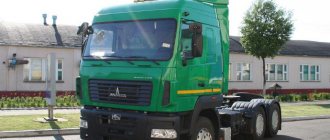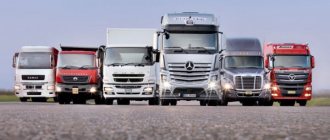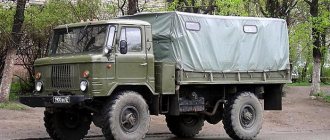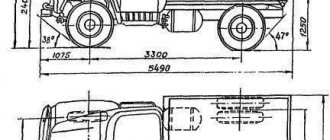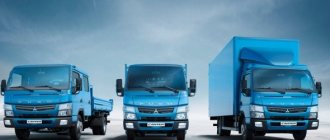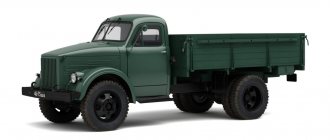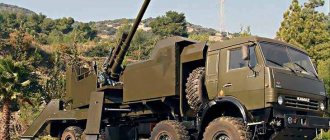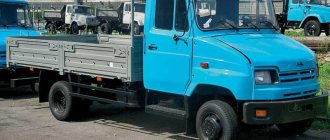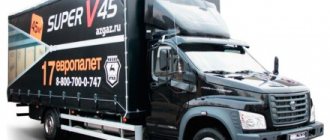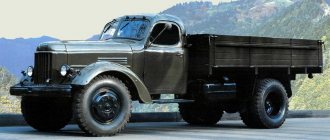Poland's Achilles heel
Piotr Kunda (Poland), photo by Wieslaw Kwiatkowski, manufacturing companies, NAMI, GSKB NIIAvtobusprom USSR
During the period of socialism, road transport in Poland experienced rapid changes both in terms of the structure and quantity of goods transported, and the rolling stock itself. The first half of the 1950s was a very difficult period for the whole country, after which, in 1956, the era of the new first secretary of the Communist Party, Wladyslaw Gomulka, began. At this time, the country's authorities made high demands on the national economy, which was recovering after the war devastation. Special tasks were set for the carriers: it was necessary to transport more and more cargo, as well as workers who flocked to the new buildings from farms and villages.
Statistics indicate the rapid growth of the importance of road transport in the life and economy of Poland. In 1955, 89.92 thousand tons were transported by trucks, and by 1970 this figure increased by almost an order of magnitude, reaching 862,579 thousand tons. The number of passengers using public transport services also increased significantly. This was one of the results of the very slow development of the private vehicle fleet - own four wheels remained inaccessible to the majority of the population. This process could be observed primarily in villages and small towns, where, due to agrarian inertia, there was often not a single car. Motorcycles became popular at this time. Those who didn’t have them were left to ride on crowded buses.
The next factor that influenced the growth of passenger traffic was the construction of paved roads and the improvement of country roads, which contributed to the opening of regular traffic on new routes.
In 1955, 151,983,000 people used the services of the PKS (State Automotive Communications) company, but 15 years later the number of passengers transported increased to 1,373,644,000. In total, in Poland in 1970, 344,680 passengers used a work subscription. The number of cities with public transport increased: from 93 cities in 1955 to 180 in 1969. The implementation of such a complex transport task required huge capital investments, rapid growth and modernization of truck and bus fleets. Thus, in 1970, over 33 thousand buses and 260 thousand trucks operated in Poland.
Sterling T26. Photo from 1945
Increased transport capabilities
From the point of view of the country's economy, a very important problem was the replenishment of vehicle fleets with vehicles of increased carrying capacity, which could quickly increase the efficiency of transportation. In order not to completely depend on imported equipment, the government ordered the development of its own designs that could help solve this problem. The development of a truck with the corresponding indicators had been going on since 1952, but the first prototype, called A 80, was released 3 years later. There were many difficulties in designing the car, especially in developing the engine. The first pilot batch of Zubr A80 trucks was manufactured at the Jelcz plant and sent to operators at the end of 1959. After this, the plant began industrial assembly. Operation in real conditions, unfortunately, revealed a number of shortcomings. What caused them?
The technical characteristics of the cars can hardly be called outstanding, but at that time they were not so bad: initially the Zubr received a 5-speed gearbox, similar to the MAZ-200. The truck in this configuration could be accelerated to a maximum of 72 km/h with a fuel consumption of 25 l/100 km. There was no room for the driver to rest in the cabin above the engine, and the low roof and engine cover limited the living space inside. Interestingly, the windshields could be opened to improve ventilation, just like on Soviet KrAZ trucks. With a curb weight of 7250 kg and a load capacity of 8 tons, the vehicle could tow a trailer with a total weight of 14 tons. Later, an interesting version of the C90 truck tractor was developed, capable of operating as part of a road train with 20-ton semi-trailers, two types of dump trucks A-01 and A-02, and also a tourist bus Zubr A81 Odra. If the latest modification had gone into production, perhaps Poland would have done without a license to produce Czech Karosa buses.
But the weak link of the “Bison” was not the cramped cabin, but the 6-cylinder, 4-stroke in-line diesel engine S-56, which, according to factory data, produced 140 hp. at 2200 rpm and maximum torque 490 N.m at 1900 rpm. This characteristic turned out to be only a theory, since the engine did not reach these indicators, in addition, it worked too loudly, and vibrations were transmitted to the control mechanisms. A catastrophic mistake by the engineers was tilting the power unit at an angle of 60°, which complicated maintenance, especially replacing the cylinder head, and led to increased oil consumption.
Golden Anniversary: Western Star Trucks
Half a century ago, Western Star trucks appeared on the roads of North America and became an integral part of the transport system.
Valery Vasiliev
UNDER THE WING OF WHITE MOTOR
Western Star Trucks owes its origins in 1967 to the American corporation White Motor Co., which wanted to strengthen its position by creating a new division.
The ancestor of the Western Star - truck tractor model 4864 (1967)
Production of trucks designated White Western Star, which met the weight standards of the western states of the United States (hence the name Western Star), was launched in Ogden, Utah. The basis of the line was the hooded models 4800 and 4900 (4x2 and 6x4) with a total weight of 21–28 tons for long-distance transportation and construction. The vehicles were equipped with diesel engines with a capacity of 175–380 hp. s., mechanical 10–13-speed gearboxes, larger radiators and sleeping compartments behind the cab on long-haul tractors. The new trucks differed from the basic White 4000 series in their lightweight design. Thus, frame spars and cross members, radiators, fuel tanks, wheel rims, bumpers, cabin parts and crankcases of a number of units were made of aluminum, and the tail was made of fiberglass. The machines were constantly improved, their production increased.
Dump truck on White Western Star 4964WD chassis (1971)
In 1978, the company released the Western Star COE (6x4) truck tractor with a cab over the engine, which became an improved version of the production model White Road Commander 2. The driver was provided with a spacious living compartment with two sleeping berths, improved interior trim and a radio radio. The car was equipped with a Cummins diesel engine with a capacity of 280 or 350 hp. With. and a Roadranger 13-speed manual transmission. In the future, Western Star never returned to the cabover theme.
IN FREE SWIMMING
In 1981, when White's parent company was on the verge of bankruptcy and taken over by Volvo Trucks, Western Star truck production ceased and the Canadian operation briefly became a subsidiary of White. But three years later it was closed, and the enterprise in Canada became an independent company, Western Star Trucks Inc. She continued the production of the bonnet family, which served as the basis for the production program in subsequent years.
Trunk tractor Western Star COE (6x4) with cab over engine (1978)
Keeping White traditions, the company continued to produce class 8 trucks (gross weight over 15 tons) with units from American companies: Caterpillar, Cummins and Detroit Diesel diesel engines with power from 260 to 550 hp. pp., Fuller or Spicer multi-speed gearboxes, Rockwell drive axles. Western Star independently produced only frames and cabs, widely using aluminum alloys.
Tractor with sleeper compartment White Western Star 4900 (1981)
For quite a long time, the production program was dominated by Kanothfero 6x4 models in numerous variants, forming the Heritage series.
Western Star 4964A dump truck (1986)
In 1990, Western Star became the property of Australian entrepreneur Terry Peabody. Since 1991, the trucks have received a more streamlined cab and tail, developed jointly with DAF for the new Constellation range. Both series, which included models with a gross weight of 23.4–35.5 tons, could operate as part of road trains with a gross weight of 76.5 tons, and in special versions - up to 120 tons. All trucks were equipped with a short Single Eagle sleeper compartment or an extended Double Eagle with internal width 2235 mm. Upon request, more comfortable Phantom and Galaxy sleeping bags were installed.
Western Star Heritage Series 4964 Trunk Tractor (1989)
In the 1990s, Western Star had more than 4 thousand modifications in its arsenal, produced at factories in Canada, New Zealand and Australia (5 plants in total). Since 1997, after the acquisition of ERF, Commander trucks with an English EU cab have been produced in Australia and New Zealand. In addition, special all-wheel drive timber trucks and dump trucks were offered.
AS PART OF THE GERMAN GIANT
In 2000, Peabody sold Western Star to Freightliner LLC, the North American division of DaimlerChrysler (now Daimler AG). In October 2002, the production of trucks was transferred to a plant in Portland in Oregon (USA), where they were assembled on their own line along with heavy Freightliner vehicles. In 2005, the company's headquarters moved from Willoughby to Redford, Michigan, where Freightliner's main engine manufacturing plant was located. At the same time, Western Star cars were filled with Mercedes-Benz units of German and Brazilian production. The reorganization of the company did not lead to a change in its program, which still consisted of the 4900 and 6900 hood series, which received a new unit base.
Western Star 4864 Constellation series (1991)
The main share of production fell on the multi-purpose 4900 family (4x2, 6x4, 6x6 and 8x4), which included trucks, dump trucks, timber carriers, special chassis with a gross weight of up to 50 tons and long-haul tractors for working as part of 76-ton road trains. The base models 4900FA and 4900SA differ in the location of the steered axle - conventional or shifted back. The 4900EX series is formed by cars with classic angular tail shapes, including the LowMax low-frame version with air suspension and low-profile tires. The vehicles are equipped with Caterpillar and Detroit Diesel engines with a capacity of 210–600 hp. s., mechanical or automatic transmissions with a number of stages from 6 to 18, leaf spring or AirLiner air suspension. Five variants of Star Light Sleeper (SLS) sleeping compartments with different roof positions and interior levels became an accessory for truck tractors, and in 2003 a comfortable integrated Stratosphere compartment with an internal length of 2083 mm appeared. 4900XD variants, including all-wheel drive versions, are designed to withstand heavy loads and severe operating conditions.
Recovery vehicle based on Western Star 4900 series chassis (1996)
The 6900 family in TS and XD versions (6×4, 6×6, 8×4, 8×6, 8×8, 10×6) consisted of reinforced chassis weighing up to 66.3 tons for operation in particularly difficult road and climatic conditions and truck tractors for working as part of road trains with a gross weight of up to 227 tons. They are equipped with Detroit diesel engines with power from 425 to 600 hp. s., Eaton Fuller manual transmissions (10, 13, 15 and 18 steps) or Allison automatic units, leaf spring or air suspension.
Western Star 4900 tractor (2000)
Western Star Trucks approached its 100th anniversary fully armed. Customers are offered trucks of five families - 4700, 4800, 4900, 5700 and 6900. The 4900FA and 4900SA series vehicles replaced the 4900SF and 4900SB models (4x2 and 6x4) with Detroit diesel engines (350–600 hp). A 4900TS (8x4) modification has appeared for installing large add-ons with Detroit engines (350–505 hp)
Western Star 6900XD chassis with oversized cargo platform (2006)
Models of the 4700 series (4x2, 4x4, 6x4 and 6x6) in SF and SB versions, respectively, with a standard or rear-biased front axle, are equipped with Cummins diesel engines with output of 260–380 hp. With. and 10-, 11-, 13-, 15- and 18-speed Eaton Fuller manual transmissions or Allison automatic transmissions.
Western Star 4800TS dump truck (2008)
The 4800 series in SB, SF and TS versions (4x2, 4x4, 6x4, 6x6 and 8x8) is equipped with Detroit engines with a power of 350–470 hp to perform various transport and technological tasks. s., manual transmissions Eaton Fuller (7, 10, 11, 13, 15 and 18 steps) or Allison units.
Mobile crane on Western Star 4700SB chassis (2011)
The most advanced tractors were the Western Star 5700XE family (6x2 and 6x4) with improved aerodynamics, which appeared in 2014. Their highlight is the new 400-horsepower Detroit DD15 diesel engine (455–505 hp) with the 1-Box environmental package. Upon request, a DD16 (470–600 hp) or DD13 (350–470 hp) will be installed. The engines are equipped as standard with an automated 12-speed Detroit DT12 gearbox. An alternative is the Eaton Fuller “mechanics” (9, 10, 13, 15 and 18 stages). Suspension - spring-pneumatic or fully pneumatic. The length of the household compartment is from 864 to 2083 mm.
Aerodynamic tractor of the Western Star 5700XE family (2014)
Tow truck on Western Star 4900SF chassis (2017)
The editors recommend:
Why do piston rings stick and how to prevent it?
A traffic police officer searched my car: did he have the right to do so?
Russians may be left without foreign cars: Western automakers have stopped supplying cars to our country
A ship that was transporting cars to Russia was detained in France
Half of the car factories in Russia have closed
News Media2
Discussion Cancel
New Generation
The engineers from Jelč waged a constant struggle with the shortcomings of the Zubr trucks, in which they always remained defeated. Attempts to improve the unfinished design remained in vain; the only solution was to replace the mechanisms. First of all, a new S 560 engine with a displacement increased to 11 liters and increased power of 180 hp was installed under the hoods of the modernized Zubrs. at 2000 rpm. A new Raba rear axle and a 315 type gearbox, which was developed in-house, were supplied. The new gearbox had better performance than the Mazov one, but the real turning point was the purchase at the end of 1967 of a license for the engine from the Leyland company, which was successful during this period.
Truck with SW 680 engine developing 200 hp. at 2200 rpm, and with a new modernized cabin received the designation Jelcz 315M. Other changes that are worth paying attention to are the Csepel or Bendibenca steering and the dual-circuit braking system of the American company Westinghouse (licensed again!) Serial production of such trucks began in 1968. Jelcz 315 became the ancestor of a number of models, which for many years were the main heavy trucks of the country. This family includes models 316 - a three-axle with increased load capacity, a 317 truck tractor and a dump truck with three-way unloading 3 W 317-821.
The design of the Zubr and Jelcz 300 series, created through long development, became the main vehicle of Polish road carriers until almost the 1990s. You can still see representatives of the 300 series on the roads of Poland, but these are the “last Mohicans”, which will undoubtedly soon end their journey. Most of them work on short-distance routes: in the fire department, in utilities and road services. Even Jelcz 317 saddlebags have not gone on long-distance flights for a long time.
Average weight
Next to the Jelcz automobile plant, trucks were also produced by the Star plant from Starachowice, but these were vehicles with a smaller payload and special 6x6 trucks, which mostly entered service with the Polish Army, and were also exported in the 1970s to the USSR and Hungary.
Operators primarily used the Star 20, the first post-war Polish truck that replaced German trucks, and the licensed Lublin 51 from the FSC plant. The last copies of the Star 20 rolled off the assembly line in 1957, and the successors were the Star 21, Star 25 and Star 27 models. Outwardly, they are similar to the ancestor. The difference is in the components. Star 21 received a new 5-speed gearbox, and the load capacity was increased to 4 tons. The in-line gasoline “six” remained the same as that of the Star 20, the S42 model developed 85 hp. at 2800 rpm and 246 N.m at 1700 rpm. Star 25 was equipped with a more powerful 95-horsepower (at 3000 rpm, 270 N.m at 1500 rpm) S470 engine. Engineers from Strahovice initially wanted to place the 5-speed, non-synchronized gearbox lever under the steering wheel, like on cars, but then it moved to the floor. A car with a curb weight of 3425 kg and a payload capacity of 4 tons burned 27 l / 100 km.
In the 1960s, due to the noticeable obsolescence of the design, it was decided to develop a new truck. In order to rid the car of all kinds of shortcomings, first of all, intermediate models equipped with a large number of new components that were tested in real conditions went into production. Since 1969, the plant has produced the Star 28 truck with the S530 diesel engine and the Star 29 with the S47 gasoline power unit. The news that immediately attracted attention to these trucks was the new cab, which was nothing like those produced before. This design was developed jointly by engineers from the Polish company Star and the French company Chausson. It was a step towards improving working conditions for drivers. The cabin in the new frame received a large windshield, which provided an excellent view of the road, a more efficient heating system and an adjustable driver's seat. The cabin was characterized by better sound insulation. Serial production of the Star 200, the design of which incorporated all the experience gained during the production and operation of its predecessors, began in 1974.
Off-road conqueror
The plant in Starachowice developed and began mass production of an SUV with a 6x6 wheel arrangement. The number one buyer of this truck was the army. Star 66, later designated as 660, began to be created already in the 1950s. The first copy rolled off the assembly line in 1955 and was demonstrated to spectators at the Poznan Motorization Exhibition, where it caused a great sensation. The Star 660 had excellent technical characteristics, especially cross-country ability. The liquid-cooled power unit produced 105 hp. at 3000 rpm (310 N.m at 1650 rpm). The 6x6 wheel arrangement and a non-synchronized gearbox with a range multiplier with a gear ratio of 1.47 (on the highway) and 2.72 (off-road) helped in overcoming obstacles. The front axle drive was engaged mechanically. Rear bogie axles with differential locks. The maximum climbable climb is 33°, the descent is 45°. Initially, the Star 660 cabin was open-type, with a folding canvas awning. The load capacity on a good road reached 4 tons, and in off-road conditions - 2.5 tons (fuel consumption 37 and 52 liters per hundred, respectively). The Star 660 became the main medium-duty vehicle for the Polish Army for many years. In addition to its excellent cross-country ability, the car was distinguished by its simplicity of design and maintenance, which allows it to still remain in the military reserve.
Polish self-propelled guns
In pre-war Poland, as well as in other European countries, SUVs were developed exclusively for the army. This is not surprising, given that the situation in the world was becoming increasingly tense, and the demand for expensive and complex 4x4 vehicles in the civilian market was minimal. If there was one at all. However, by the beginning of World War II, the Poles still did not manage to organize any kind of mass production. Therefore, all four-wheel drive vehicles (self-propelled vehicles in Polish) either remained at the concept stage or were produced in quantities of less than two dozen.
The development and production of army all-terrain vehicles in Poland was carried out by the holding company Panstwowe Zaklady Inzynierii (National Engineering Enterprise), abbreviated as PZInz (read as “PZ-Inzh”). It was created in 1928 and included several factories that produced a wide variety of equipment: from motorcycles to tractors and tanks. Cars were produced under license from FIAT, and in relatively small quantities. Before the fateful September 1939, only ten thousand of both civilian and military self-propelled guns rolled off the PZInz assembly lines. At the same time, as in other European countries, the Polish army adopted special modifications of rear-wheel drive vehicles, which in those years were considered quite SUVs. For example, the artillery tractor C4P, also known as WZ.34, created on the basis of a FIAT 621 truck with a carrying capacity of 2.5 tons, the rear wheels of which were replaced with rubber tracks modeled on the French Citroen Kegresse. Such a half-goose could tow a cannon weighing up to 2.4 tons. Its 2.5-liter gasoline engine produces 46 hp. accelerated the tractor to 35 km/h. At the same time, fuel consumption was truly impressive - 60 liters per 100 km! Although at that time this was not the limit. In total, about 400 of these machines have been built since 1935. In addition to it, there was an easier version - C2P. And the Poles were also armed with the lightweight, almost all-terrain vehicle Polski FIAT 508/518 (aka PZInz.302). Increased cross-country ability was achieved due to the reduction gear, differential lock and low installation of rotating spare wheels on the sides, which helped not to sit on its belly. In addition, some modifications were equipped with winches. The PZInz.357 engine with a displacement of 2.0 liters developed a power of 45 hp and a maximum speed of 65 km/h.
The PZInz.357 engine with a displacement of 2.0 liters developed a power of 45 hp and a maximum speed of 65 km/h
PZInz.357
Tractor PZInż.342 (1939)
A serious rearmament of the army was planned in 1939–1940, and a whole line of new equipment was being prepared for this. It included, firstly, a new passenger all-terrain vehicle PZInz.303 (with the same PZInz.357 engine), which was created by a team of designers led by Jerzy Werner with an eye on the Mercedes-Benz G5 SUV. The Polish car was equipped with all-wheel drive with a reduction gear in the transfer case, locking cross-axle differentials and even all steering wheels, thanks to which the turning radius was 3.3 meters. The gearbox is four-speed, and the suspension is independent lever-spring. The spare tires on the sides rotated like those of the 302 model, and if this did not help, the winch came to the rescue. Ground clearance – 250 mm. The new self-propelled gun weighed 2 tons and reached speeds of up to 60 km/h. It was planned to supply the army with 90 copies in 1939 and several hundred more the following year. But you know what happened in the fall of 1939, and before the evacuation of part of the PZInz factories to Pinsk, they managed to build only 10 units of various modifications.
Secondly, two universal half-track tractor-transporters with steel tracks were prepared. One of them - PZInz.222 - could pull a trailer up to 1,150 kg. The engine was the same PZInz.357, the ground clearance was 280 mm, and the speed was 45 km/h on the highway. Alas, only 12 copies were produced before the start of hostilities. Even more rare was its heavier version PZInz.202 (pulled up to 5 tons) with a licensed diesel engine from the Swiss company Saurer (5.32 l, 65 hp, 50 km/h).
The review of pre-war Polish all-terrain vehicles is completed by the PZInz.343 and 342 tractors, produced in a pilot batch of 9 pieces. Both cars were developments of the 312 model, which turned out to be too complex and expensive. Both all-terrain vehicles were equipped with all-wheel drive with reduction gears and differential locks, winches under the body and dependent leaf spring suspension. Under the short hoods there were standardized six-cylinder petrol engines. The lighter (4.2 tons) 343 received a 4.6 liter engine with 75 hp. and could pull a gun weighing up to 3 tons. But the 342nd (4.4 tons) could already tow a five-ton gun, and it had a more impressive engine - 5.2 liters, 100 hp. Speed – 70 and 60 km/h respectively.
During the occupation of Poland, the fate of the holding was tragic. A significant part of the equipment and machines ended up either in Germany or in the USSR, the factories were destroyed. The staff were mostly either killed or sent to concentration camps. However, in all this darkness there was a ray of positivity. The latest development - rear-wheel drive PZInz.713/723 - became the basis for the first post-war Polish truck, Star 20 (1948).
POPAL TRUCK
Here, perhaps, it is worth stopping and explaining that the name of the Star truck brand does not come from the English word “star” at all, but from the shortened name of the city of Starachowice, where the Fabryka Samochodow Ciezarowych (Factory of self-propelled cargo vehicles), abbreviated FSC, was located. Initially, self-propelled vehicles were produced only with rear-wheel drive, but already in 1951, the State Planning Commission for Economics and the Main Directorate for Planning of Weapons and Military Equipment gave the task to develop a new all-wheel drive truck. The main requirements are unification with the Star 20 model and the presence of two main modifications 4x4 and 6x6. The project manager was Jerzy Werner, who successfully survived the war. By mid-1953, prototypes of the Star 44 (4x4) and Star 66 (6x6) began making circles around the training grounds. Unfortunately, only the three-bridge version made it to the assembly line. It was put into production in 1958 and was quickly modernized, and at the same time renamed Star 660.
The “660th” was equipped with an in-line six-cylinder gasoline engine S-47A (4.68 l, 105 hp). Valve mechanism - OHV. The gearbox is five-speed, the transfer case is two-speed with pneumatic switching. The front axle is plug-in. Both rear axles are equipped with pneumatic differential locks. Brakes – hydraulic with pneumatic booster. The length of the truck was 6.5 meters, and the weight in running order was 5.2 tons. The American-style load capacity is 4 tons on the highway and 2.5 tons on the ground. Speed – 75 km/h. Ground clearance – 285 mm. In 1965, the modernized Star 660M1 appeared, and three years later - Star 660M2 and Star 660D. Both received six-cylinder S530A diesel engines with a displacement of 6.2 liters and a power of 100 hp. Moreover, the 660M2 continued to be produced in a gasoline version.
Star 660s were mainly supplied to the Polish army or served as chassis for fire trucks. In the USSR they were almost unknown. The Jelcz 574 mobile workshop on the Star 660 chassis, and later the Star 660M2 with a carburetor engine, was delivered to us in small quantities. Sometimes these cars were even featured in films, depicting capitalist foreign cars. And the peak of the 660’s career was 1979, when two “popemobiles” were built especially for the arrival of Pope John Paul II. Both cars were converted into open-top buses and equipped with loudspeakers and microphones. In addition, the transmission gear ratios had to be changed so that the car could travel at the speed of a leisurely pedestrian.
NEW DESIGN
In 1973, the successor to the 660, the Star 266, appeared with a new closed, non-tilting cab. At the same time, the old model was discontinued only after 10 years. Perhaps the military liked the convertible truck, although the 266 could also have a ventilated cabin. To do this, it was enough to raise the front windshields and open two hatches in the roof. Load capacity – 5 tons on the highway and 3.5 tons on the ground. The truck was equipped with a six-cylinder diesel engine type 359 (6.8 l, 150 hp), a ZF gearbox with five gears, a two-stage transfer case and a front axle connected using electromagnets. The brakes are pneumatic-hydraulic, and the steering wheel finally received a hydraulic booster. Speed – 90 km/h. It was supplied to the armies of many countries, most of all to Angola, and participated in the Paris-Dakar rally in 1988. True, without much success. Already in the 2000s, the Star 266 in service began to be gradually modernized. The VW MAN division, which by that time had acquired Star, began installing new German folding cabs, turbodiesels and other attributes of modernity. And in 2010, the Autobox company began converting old cabins into folding ones. In addition, the outdated engine was replaced with a modern Iveco Tector 4 turbodiesel with a power of 170 hp. And a little later, Star began to be equipped with cabins from the Chinese version of MAN.
EXTINCTION SPECIES
In Poland, as in other CMEA countries, citizens were entitled to many liberties that Soviet people could only dream of. For example, the opportunity to farm, and not just garden, and even purchase light commercial vehicles for this. And so, especially for peasants, in 1972, production of the Tarpan 233 pickup truck, named after a small wild horse, began. The car, which was produced by the Fabryka Samochodow Rolniczych (Factory of Rural Self-Propelled Vehicles), abbreviated as FSR, was distinguished by a simple, bordering on ugliness, body. At first, in order to reduce the cost of the product, they didn’t even put a bumper on them, and the welds were demonstratively put on display. The new agricultural self-propelled vehicle was unified with the small Zuk truck and the Warszawa passenger car. For example, from the latter they took the S-21 engine (2.1 l, 70 hp) - this was enough to accelerate to 100 km/h. The gearbox was four-speed, the brakes were drum on all wheels, and the load capacity was 600 kg.
In 1976, at the request of workers, Tarpan was improved. The quality has been improved, the body has been strengthened, and the design has been significantly refined. The engine was supplied from Polski FIAT 125p (1.5 l, 75 hp). With it, the speed increased to 110 km/h, but cross-country ability was still mediocre. Which, in general, is not surprising; with rear-wheel drive, small wheels, and even the independent spring front suspension from Warsaw, you can’t really drive through the mud
Family of modernized Tarpan 233 (1976) on the lawn
Experienced Tarpan PW2
Serial Tarpan Honker phaeton from Andoria
In 1976, at the request of workers, Tarpan was improved. The quality has been improved, the body has been strengthened, and the design has been significantly refined. The engine was supplied from Polski FIAT 125p (1.5 l, 75 hp). With it, the speed increased to 110 km/h, but cross-country ability was still mediocre. Which, in general, is not surprising; with rear-wheel drive, small wheels, and even the independent spring front suspension from the Warsaw, you can’t really drive it through the mud. Only towards the end of the 1970s did the 237 model appear with fully dependent leaf spring suspension on all wheels and a differential lock. Load capacity increased to 1 ton. Later they began to install a licensed Perkins diesel engine (49 hp). But the experimental all-wheel drive Tarpan 234 (1978) never went into production.
The full-fledged SUV PW-2, also known as Tarpan 4011, also known as Honker in the latest edition, debuted only in 1988, although work on it began back in 1979. It was distinguished by its simplicity of design with a fully dependent leaf spring suspension and a body on a frame. The gearbox is five-speed, the rear differential is lockable. Production was small-scale from the very beginning. In the best year of 1990, only 589 cars were produced. And in 2001, for comparison, there were about 40, which immediately made the car a “bibliographic rarity.” Over the years, it was equipped with either gasoline engines (including those from the Polish FIAT), or Iveco SOFIM (2.5 l, 75–100 hp) and Andoria (2.4 l, 90 hp) diesel engines. Honker himself went from bad to worse in the second half of the 1990s. It belonged to Daewoo and Andoria and eventually ended up in the hands of the Russian company Intrall. It was discontinued in 2007 due to low demand.
Text Georgy Varfolomeev
Looking for the best bus
The first bus manufacturer in post-war Poland was the Sanok Bus Plant, today's Autosan SA plant. Since 1952, the plant has produced the Star N52 model with limited passenger capacity (31 seats). In this regard, the unfinished San H01A went into production in 1958. With a length of 9370 mm (wheelbase 4550 mm), the interior of the new “San” could accommodate 43 passengers and a crew of two (driver + conductor). The design uses the S 42 power unit, known to owners of Star 20 and Star 52 trucks, and uses a non-synchronized 5-speed gearbox. San H 01 A could race at a speed of 80 km/h, while consuming 28 liters of gasoline per 100 km. However, the seemingly impeccable bus had a bunch of shortcomings. The most unfortunate decision of the designers, which caused huge problems, was the body of the bus. The source of these problems was the lack of components necessary for the carriage layout - the engineers designed the bus in the shortest possible time and only with the local auto industry in mind, where components from Star trucks remained available. Their engines were not suitable for large airliners as they were too weak. The only solution was to reduce the dead weight of the new bus designs. This was done by replacing a powerful spar frame with a supporting body made of light steel profiles, fastened to the supporting elements with screws. Polish roads at that time were in poor condition, and buses traveled overloaded almost every day. As a result, the bodies cracked in stressed areas, and the cladding sheets rusted, so the old buses could not be repaired and were sent for scrap.
Buses with a monocoque body were produced at the Sanok plant until 1967, when the first San H100 with a durable spar frame rolled off the assembly line. Many components from the San H27 were used in the design of its body. In the intercity version H100 A, the new San was designed to carry 41 passengers, and in the city H100B - 62 passengers. Two power units were available: a 6-cylinder diesel (100 hp at 2600 rpm, maximum torque 330 N.m at 1600 rpm) and a 6-cylinder gasoline (105 hp at 3000 rpm) min and 294 N.m at 1500 rpm).
Post-war “Sans” with a monocoque body were also produced in urban configuration. San H01B became the first domestic bus of this type, and its design and technical parameters did not differ from the intercity San H01A. The main components were identical. The difference was in the modification of the right side of the bus, where instead of a manually opened door, there were two double doors (in front and behind the body), but without an electro-pneumatic drive. The doors were opened using a mechanical backstage system by the driver or conductor. San in this configuration was designed to carry 50 passengers (37 seats) at a density of 5 people per 1 m2.
STAR
(STAR)
Warsaw/Starachowice Poland 1948-
Automobile from Starachowice, the largest Polish manufacturer of trucks, has always been the main supplier of vehicles for the Polish Army. Production of the first Star-20 truck began in December 1948, and at the same time, on its basis, a family of army all-wheel drive vehicles was created on its own. Under the direction of engineer Jerzy Werner, their development began in 1949 at the Automotive Design Bureau (BKPMot) in Lodz and then in Warsaw. In 1953, the first prototypes of the Star-44 (4x4) and Star-66 (6x6) with a 6-cylinder S44 gasoline engine producing 86 hp were manufactured there. After testing, work continued only on the 3-axle version. During the development process, it received an S46 engine (4.7 l, 102.5 hp) and in January 1956 it was ready for production, which began in Starachowice in the summer of 1958. The truck entered service in 1960. Serial “ Star-66 was equipped with a 105-horsepower S47 engine, a 5-speed gearbox with a 2-speed transfer case, hydraulic brakes with a vacuum booster, an open 2-seater N66 cabin with a folding windshield and a metal body with an awning for transporting 24 soldiers.
Star-66, 6X6, 1959
Star-660M1, 6X6, 1969
Star-200, 1977
Star-744, 4X4, 1996
Star-266, 6X6.1978
Star-266M, 6X6, 1994
On the highway its carrying capacity was 4 tons, on the ground - 2.5 tons. It reached a speed of 74 km/h, overcame a 33% grade, ford 90 cm deep and could tow a 4.5-ton trailer. In 1962, production of the 660 model began with a synchronized gearbox, reinforced front suspension, wider tires with a pressure control system and shielded electrical equipment. In the 60-70s. modifications appeared: “660M1” and “660M2” with carburetor engines and “660D” with a 100-horsepower diesel engine. They became the main trucks of the Polish army and the base for a variety of military equipment - workshops, bridge layers, pontoon carriers, cranes and excavators.
In 1999, the reconstructed Star-660MZ appeared with a 170-horsepower IVECO diesel engine with turbocharging, a new transmission and braking system, reaching a speed of 110 km/h. Star's first own military developments included the SG-160 half-track artillery tractor, built in the early 60s. in one copy
In 1975, the plant switched to the production of a more advanced 6-ton civilian truck "Star-200" with a Polish 6-cylinder diesel engine S359 (6.8 l, 150 hp), which was used in the armed forces of the People's Republic of Poland for general transport, and It was also equipped with bodies from the Kielce Special Vehicles Plant SHL (SHL). In 1971, on its basis, the 3.5-ton army truck Star-266 (6x6) was created, produced since 1976. It received a synchronized 5-speed gearbox, power steering, and a dual-circuit pneumatic braking system , a 6-ton winch and a closed 2-seater all-metal cabin with a berth. The truck could operate at ambient temperatures from -40 to +50 °C, reach a speed of 90 km/h, overcome 35′ steep climbs and a 1.8-meter ford.
Military tankers, tank trucks, repair shops, various vans, bridge layers and light weapons were offered on its chassis. In the 90s the latest version of the Star-266M received modernized chassis components and assemblies, as well as a new front facing.
Star-944g 4X4, 2001
Star-1466, 6X6, 2001
BM-21 rocket launcher on the Star-1466DK chassis, 6X6, 2001.
Political and economic upheavals in Poland in the last two decades of the 20th century led to the transformation of Star into a joint stock company. In the mid-90s. He supplied the Polish army with a new 3.5-ton truck "744" (4x4) with the same 150-horsepower diesel engine, short or double cab. By the end of the 90s. Star's long-outdated products were no longer in demand even in their own country, and the plant was on the verge of collapse. On December 17, 1999, it became owned by the German company MAN, becoming its branch for the production of trucks of the S2000 model range.
A year and a half later, Star presented its new tactical trucks “944” (4x4) and “1466” (6x6) with a gross weight of 14.2 and 22.5 tons, respectively, based on foreign units. They received MAN diesel engines with a power of 155 and 220 hp, a 6-speed gearbox and a ZF steering gear, new drive axles and a braking system with ABS, and all-metal MAN L2000 cabs in three lengths. The cars reached a speed of 93~105 km/h, could cross a ford 1.2 m deep and overcome slopes up to 39°. Their chassis served to install various bodies and weapons, including the 40-barrel 122-mm multiple launch rocket system BM-21, a modernized version of which is produced by the Huta Stalowa Wola industrial plant.
Table of contents
Polish-Czechoslovakian marriage
Despite the efforts of SFA engineers in Poland, it was not possible to create a bus with a large passenger capacity. Help came from the Czech Karosa plant. In December 1958, an agreement was concluded on the basis of which the Polish Jelcz plant began production of the Karosa 706 intercity bus under the Jelcz 043 brand. Components were supplied from Czechoslovakia, but over time the Poles had to switch to their own body production. The main component - the chassis - was supplied by the Karosa plant in Poland until the end of assembly. This factor influenced the limitation of the scale of production. The first Jelcz buses rolled off the assembly line in 1959, and the number of units produced was constantly increasing. This saved the lives of many passenger carriers who did not have enough buses. The technical characteristics of Karosa 706 are well known to readers, so there is no need to repeat information about the features of its design. In principle, Poland did not introduce any special changes to the design of the bus, but several modifications were developed according to local requirements. The first place in the number of copies produced was undoubtedly occupied by the city Jelcz 272 MEX, the production of which lasted from 1963 to 1977. In order to increase transport capabilities, buses of this type often towed passenger trailers.
In addition, the first Polish mega class bus was made on the basis of the Jelcz 272 MEX. In 1963, employees of the Warsaw MPK (City Transport Company) made a prototype of the AP 62 accordion from two buses of type 272 that were damaged in an accident. The bus, 17,750 mm long and with a gross weight of 22.9 tons, could accommodate 142 passengers (46 seats). Three double doors led into the salon. Unfortunately, the weak 160-horsepower engine made the bus undynamic and thirsty (gasoline consumption was over 40 l/100 km). Then the engineers of the Jelcz plant created a modernized version of the AP 02. Apparently, the Warsaw municipality liked the bold development; in addition, the country needed such buses. In 1967, the Jelcz 021, 15.88 m long and with a passenger capacity of 137 people, entered the streets of Polish cities.
Jelcz articulated buses were unable to resolve the tense situation in the country's urban transport. They were replaced at the very beginning of the 1970s by the dynamic Ikarus 280, which could accommodate up to 180 passengers.
